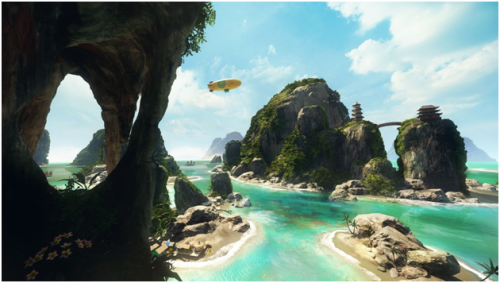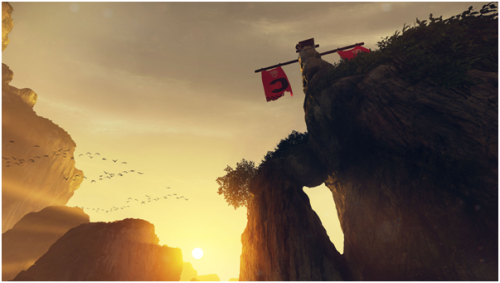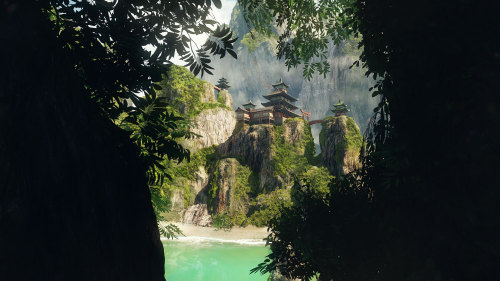
Wish You Were Here? How We Created an Asian Themed Rock Climbing Paradise
Asia Blog Part 1 by Pascal Eggert, Art Director

When we first thought about where a VR climbing game should take place, it seemed obvious to take inspiration from some of the most stunning natural locations on earth. After all, for many people, this could be their first contact with a VR experience, and we’d like it to be as impressive and beautiful as possible. Photorealism would not be enough; it would have to be “desktop wallpaper realism.” So rather than replicate real life places exactly, we decided to take the approach that people who make desktop wallpapers or postcards adopt: take the best possible perspective and light, bring together iconic elements from the area and retouch it all to perfection.
When it came to creating our Asia setting, we were particularly inspired by Halong Bay in Vietnam. Halong Bay is a World Heritage site featuring beautiful islands, arresting rock formations, and stunning waters. It’s a major tourist destination, and its limestone pillars have drawn climbers from across the world, including free solo rock climbers who go to explore unchartered territory and enjoy spectacular ascents in this area of outstanding natural beauty. For us it was a starting point where we could bring in other Asian influences and features, to create a larger than life holiday feeling.
To truly get the “postcard” feel we wanted to achieve, we also took inspiration from another genre of games, which had done something similar in the 90s: arcade racing games. A lot of people on the team have fond memories of old-school racers like Daytona, Ridge Racer and Screamer. Those games really popped with color and had striking environments with the bluest of blue skies. And for some reason there was always a random helicopter flying around, so obviously we needed one too.

Another thing we did to create “our imagined perfection” was to increase the scale of everything. We made rock formations even larger so that we could provide different routes and challenges that created a real rock climbing playground. On the one hand, that opened up more gameplay possibilities. But from an artistic perspective, it played into our desire to give players awesome views with incredible draw distances that work fantastically in VR when you’re looking around from the rock face.
The recurring theme was to ask “is it as awesome as you could possibly imagine?” If not, make it larger or find something else that fits. We took liberties and cherry picked from regions all across South East and East Asia. We looked to some of the beautiful beaches, bays and mountains from Thailand, like Krabi and “James Bond Island” for instance, and to China, Japan and other areas of Vietnam too. It wasn’t just geographical features – we also brought in things like temples, junk boats and elements from holiday resorts that you find across the region, which all give the level a feel of human activity. There was no requirement to be rigid – if it looked good and we could take inspiration from it, we did.

We worked hard on the near cliff surfaces that the player climbs on. Naturally we brought in the kind of vegetation you’d expect to see from the region. We also wanted to have a feeling that the places you are climbing through are humming with life so as you climb, you’ll come across birds and animals too. After all, you’re climbing around in their home, and VR lends itself just as well to large scale vistas as to the smallest objects right in front of you.
To further fill the world with life, we tried introducing spectators. We’d have crowds of people cheering you on, giving you real-time feedback on some of the moves you were performing, and even used our random helicopter as a film crew chopper, which would pursue you as you’d climb. But unlike in a racing game, where you expect bystanders to cheer for you, the slower nature of climbing and the strong presence of VR made some players feel really uncomfortable, like they were asked to perform in front of a real audience. The feeling was just too intrusive; it added another level of stress on top of our free climbing gameplay, so we decided the player would not receive this kind of attention. But it was an interesting lesson about the power of VR immersion. Still, we kept that helicopter. Helicopters are awesome.



